I have to admit, I’m putting together (well, not making any effort to, but they’re piling up) quite the list of places that just haven’t “made the grade” recently. We had three mediocre Horde outings in a row, which had us all scratching our heads, as all three places had come well recommended (Italian, Spanish, and Argentine). Plus a new revamp of a Peruvian spot that was supposed to bring it, gleaming, into the upper echelons, disappointed sorely. And, a much touted and awaited opening of a burger spot from the northern suburbs that spent a year hyping their Palermo opening, was… okay. I’m holding off on doing a “Bite (Me) Marks” for the moment, but it may come to that….
But, thankfully, there has been good food along the way!
Sushi Sleeper
This one caught my eye awhile back simply for the cool “logo” mural of what appears to be a sort of four-handed monkey god contemplating a piece of a sushi roll. Now, as best I can tell, there’s no god of that sort in Japanese tradition, but it’s a cool mural nonetheless. Nemuri, “sleeping” in Japanese, not exactly my first choice for a restaurant name is at Moldes 1502 in Colegiales. I had nothing to go on as to a recommendation, though looking at their Instagram feed, the sushi looked good!
Points right off the bat for being completely open to making a carafe of iced tea out of any of their teas (this one red tea with rose petals, they also had a green tea with jasmine, and another one which I forget), and a nice little amuse bouche of lightly seared fish with a sort of salsa criolla.
But the super big points are reserved for the really excellent sushi. A nice little omakase of sashimi of the day – twelve pieces, mixed between salmon, tuna, prawn, and sea bass (700 pesos). Plus an interesting selection of rolls, all available by the half roll (and priced reasonably close to half the full price), many of which do not (yay) include cream cheese (ranging between about 150 and 250 pesos, depending on what’s in them). One of the best salmon skin rolls I’ve had in BA (which, this one normally comes with cream cheese, but I asked for it without, and they packed it with extra salmon skin instead). I really like that the rolls have only a very thin layer of rice, and are really chockful of the fillings. It seems expensive, but so is everywhere with good sushi these days, and there’s that plunging exchange rate (in the end, all this sushi, plus the iced tea, and tip, rang in at about $27). I’d happily eat here again. Two minor negatives – they charge a cubierto, perhaps the only sushi bar I’ve been to that does, of 70 pesos, and, they have those weird chopsticks made out of some sort of recycled and discardable material that are difficult to handle (though they have regular chopsticks available on request, too).
Whats-His-Name
Working in the restaurant world, it’s not uncommon to literally meet hundreds, if not thousands of people in a year. And It’s amazing how many of them expect you to remember their name. People have various tricks for remembering as much as they can, and of course, there are those people who just have brilliant recall. Myself, I’ve never been good at remembering people’s names, but I often remember certain things about them – I had customers who I wouldn’t see for months or a year or more, and I’d know their face, not their name, but I’d remember what they’d eaten and what wine they’d had to go with it. One of the more famous restaurateurs in NYC was (and probably still is) famed for calling everyone “Big Guy” (I’m not sure what he called women), because he knew he knew your face, but hadn’t a clue what your name was. You could take some minor satisfaction in at least knowing that he remembered he’d met you at least once before…
Every culture and language has similar sorts of devices. In Spanish slang here in Argentina, two stand out, though they’re pretty obvious – fulano and mengano, both derivatives from Arabic words. The former comes from the word fulan, meaning someone who’s been taken out of their homeland… in lunfardo, local “street slang”, it means, more or less, “some/whichever person”; the latter comes from the man kan, and in both languages means “whoever”. But they’re both used, either singly, or in a variety of expressions together, and often are away of referring to someone whom you can’t remember their name (rarely, I would imagine, since they’re so obvious, would you call the person that directly)… “Yeah, I was talking to… whats-his-name”….
Well, what’s his name is Facundo Keleman, and he’s the chef behind Mengano Bodegón, José A. Cabrera 5172, in Palermo. I’m going to start off with a pronouncement about this place. Don’t go by yourself, as I did. Just don’t. Go with at least one other person. The food style is one of plates that are very intense, very flavorful, and despite not being huge portions, eating all of one is a trifle overwhelming. They’re meant to be shared.
Except the bread… which comes as a huge, baseball sized chipa, the classic yuca flour bread of the north of Argentina, though in this version, rather than being more or less a small cheese puff, it’s a whopper. And it’s filled with a cheesy bechamel sauce, that oozes out when you break into this. It’s enough bread and richness that you might reconsider even needing to order dinner. Because you won’t be able to not finish it. But, soldier on.
I was solo on this visit, which is where my pronouncement above comes from. I just couldn’t finish these dishes – it was too much of a good thing. This is a carpaccio de gambas al ajillo. Now, gambas al ajillo is a classic dish, mostly found in more Spanish style restaurants, of prawns in a garlic and paprika broth. Carpaccio is an Italian preparation of meat or fish, sliced thin and served raw. This is loosely styled on it. It’s slices of prawns, but they’re not raw – it appears what they did is created sheets of very thin overlapping slices of prawn, and then lightly broiled them. They’re sitting atop a square of housemade brioche (seriously, more bread?), and topped with a paprika oil and lots of chips of fried garlic. It’s delicious, but it’s too much for one person as an appetizer. Split it with someone who loves garlic as much as you do.
Another one that even more obviously is for more than one person – this is easily a 14″ dinner plate, so those are two whopping big fillets of river trout, smoked, and brushed with a yuzu kosho butter, then covered with a layer of crispy Jerusalem artichokes, and accompanied by an almond bagna cauda, and a fennel and green apple puree. It could have used more of the puree, that little quenelle in the back there. With no accompaniment, like a vegetable or starch (okay, we don’t actually need a starch at this point), this needs to be divvied up between at least two people, because eating both fillets is beyond the pale, delicious as they are.
Mengano Bodegón is not cheap, nor is it outrageous. Certainly not “bodegón” prices (a bodegón is a traditional local tavern, usually serving up fairly simple, rustic dishes). The two dishes above rang in, respectively, at 390 and 820 pesos, $7 and $14, which for the international stage is a steal – in a NYC restaurant for that price you’d probably get one fillet of trout and none of the rest of the meal – but that’s probably close to double what an appetizer and main course in a classic bodegón would run you these days.
Shared Space
Those of you who’ve been regular readers for awhile will likely remember my review of two relatively new spots offering up Asian street food – The Night Market and Opio. The latter is only open Wednesday through Saturday evenings (making it difficult for me with my work schedule to get a night out for dumpling diving there). At some point earlier this year, they made a deal with a local Korean-Argentine woman and friend of Opio’s owner, Marina Lis Ra, to come in and do what essentially is a weekly “pop-up” dinner (at some point it probably stops being a pop-up) each Monday evening called Na Num (“share”, in Korean), inside Opio, Honduras 4415, Palermo. Here, she, her team, and I think the wait and bar staff of the restaurant, put out her take on modern Korean street and sharing food, much of it vegetarian or vegan.
Now, my one real critique of Opio was the service. I had chalked that up to having a waitress who was new. But, it turns out, no, it just is kind of inept. Worse, this time, the bar. In addition to the much liked gin and tonics that they offer, they have four specialty cocktails. One of them is a sriracha infused bloody mary with a prawn in it. How could I resist? Only it turns out that they don’t seem to have things well organized for these specialty cocktails, or perhaps just this one. If I’m having a cocktail, I want it on the table before food. I want to relax with it. I actually told the waitress I’d like to start with a cocktail, and then have the food come after, and I has asked for the food in a particular order that I wanted to try it (I ordered three dishes – they’re all small plates).
Instead, after about 15 minutes I received the mandu, which I’d asked to be the second dish. They’re vegan, stuffed with a mix of vegetables, and served with a tamarind sauce underneath. They need more punch – both in the filling, and the sauce – actually, the sauce was tasty enough, there was just too little of it. They were also over-fried, which sort of dried them out. 200 pesos ($3.50), which is what you’d pay at most places for 6-8 mandu. Hmm…. and where’s my cocktail? And my first course? “No idea, I’ll go check.”
As I was finishing off the dumplings, my first course arrived, second. A beef tartare made from beef tenderloin, oysters, coconut, lime, carrot, and black quinua. Absolutely delicious. Wayyyyyy too small of an amount for 340 pesos (or is it? that’s less than $6). Oh, that cocktail? “It’s coming in just a moment, he didn’t have the mix made up.”
Another bit goes by and my main course is served. Not by the waitress, who seems to now be avoiding me, but by the chef, directly. It’s pork belly lacquered in spicy gochujang, served with a few strands of daikon kimchi and some sort of green apple puree. This is pure yum, but again – four slices of pork belly for 480 pesos is a bit steep (but again, just over $8), even at today’s prices. Still, did I mention, yum? It could use something to go with it, and it turns out there’s a “para envolver” setup of all the stuff you can use to wrap various meats and such with – that comes with lettuce, sprouts, herbs, and rice, for 120 pesos more. Though, that might be a good deal if you’re getting several dishes that will do well wrapped up.
At this point, as I’m ready to plunge the first slice into my mouth, I flag the waitress down and tell her I’m no longer interested in the cocktail, I’m almost done eating dinner. She shrugs and goes to tell the bartender, who glares at me, throws down the rag in his hand onto the counter, and stomps back into the kitchen. I don’t really care. I know he’s been working on the drink, but it’s been 40 minutes since I ordered it. And, he’s not done. He decides, apparently, to finish it off, and put it in the refrigerator to await someone else ordering it – that takes a solid 10 minutes to do so (he hadn’t even cooked the prawns, nor actually mixed the drink, he’d just made the base and cut a few things up), by which time not only am I done eating, but am perusing the menu for something…
…I don’t usually do, swap to the sweet side of the menu and order dessert, but I was feeling indulgent. A spicy chocolate and gochujang brownie sounds like a winner, and it is. Beautiful balance of flavors. And maybe the first dish that’s priced reasonably, at 140 pesos.
Maybe I’m being unfair on the pricing. The Argentine peso continues to drop against the dollar, and even with water and tip, this meal of four courses comes in at 1400 pesos, or $24, which in those terms sounds like a steal. I have to start converting the prices before deciding if something is expensive these days – the changes come fast and furious.
I may, also, have been a bit peeved about my cocktail.
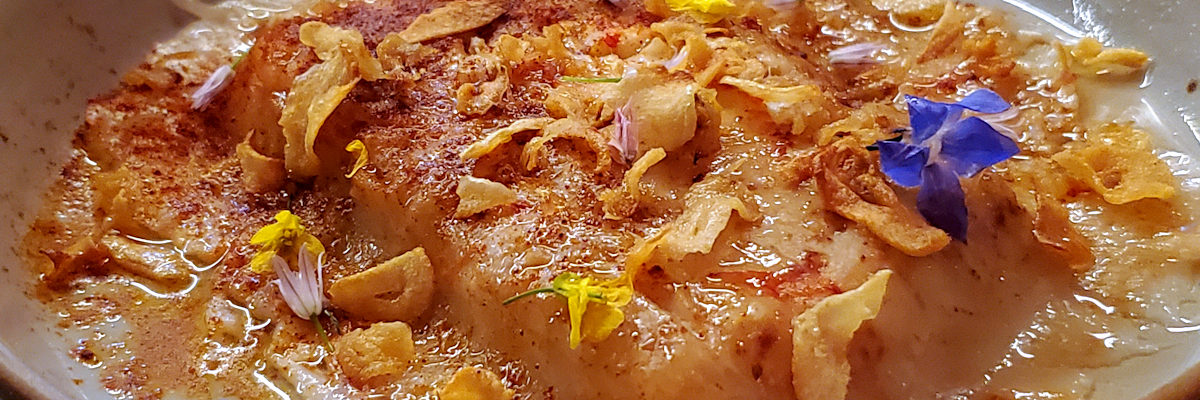
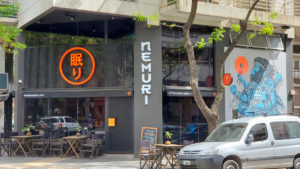


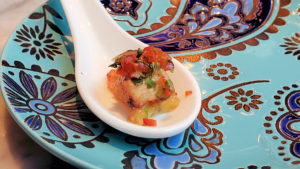
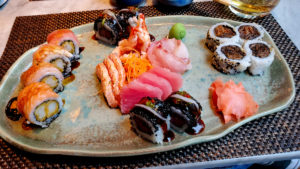
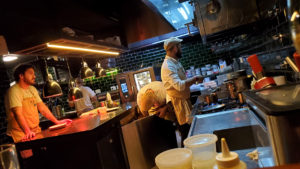
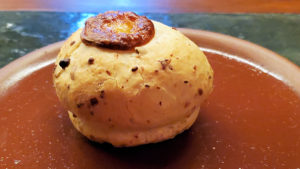


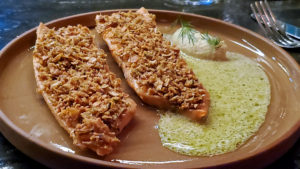
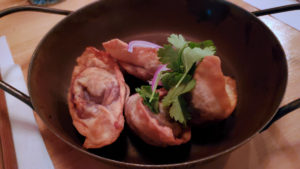
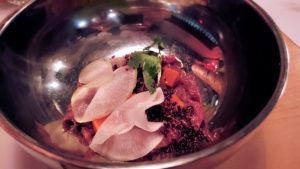
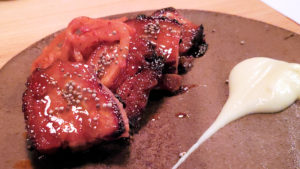

[…] mint leaves, and fried garlic. This one started out from an inspiration of the prawn carpaccio at Mengano Bodegón, a few weeks […]
[…] I haven’t heard about a single new opening this year, unless you count the weekly pop-up of Na Num on the night that Opio is closed. But a) that’s not a new space, it was already a space […]